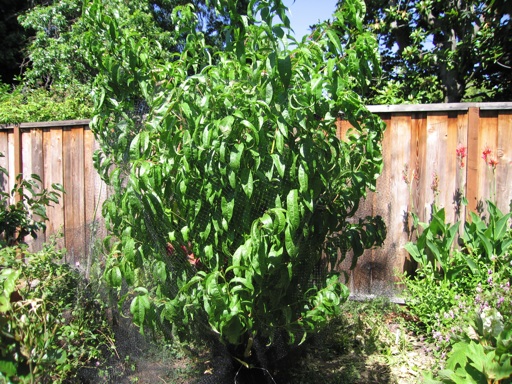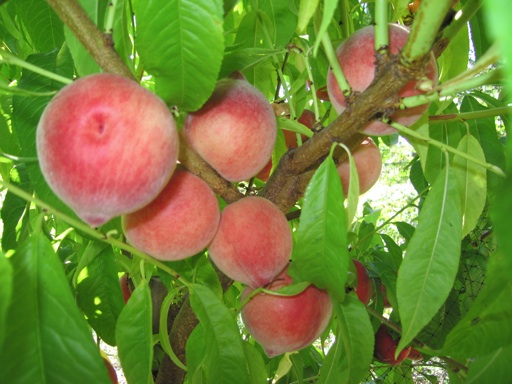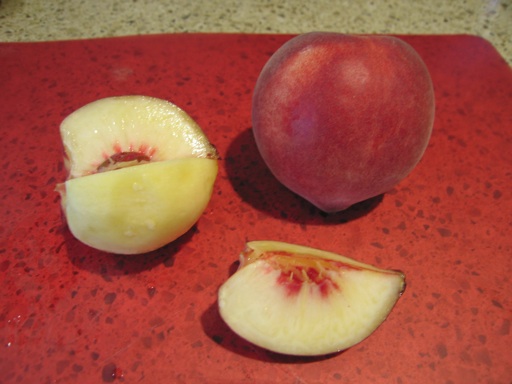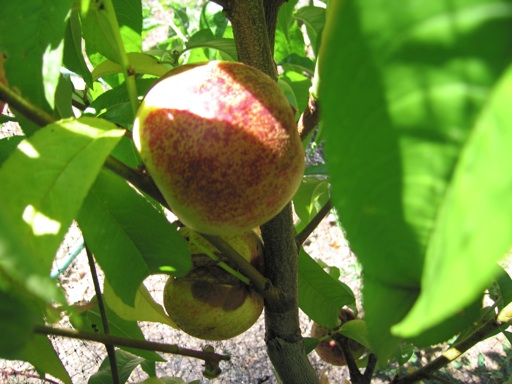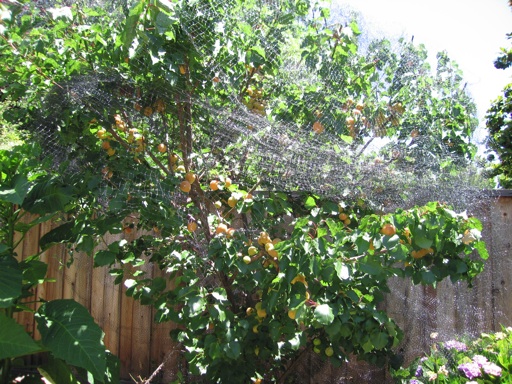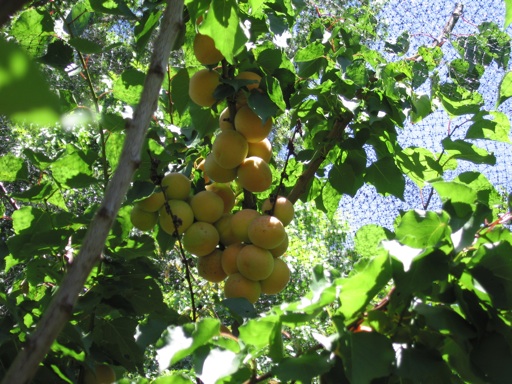White Peach v. White Nectarine
In the spring of 2009, I planted about a half dozen new fruit trees in our backyard. Two of the new trees were a Snow Beauty white peach and a Snow Queen white nectarine. This summer both trees have produced fruit for the first time. The first, second, and third photos above are pictures of the Snow Beauty tree, Snow Beauty peaches ripening on the tree, and the whole and sliced Snow Beauty fruit, respectively. All 3 pictures were taken in the past week and a half as the fruit has been ripening. Our Snow Beauty tree is a very vigorous grower. I have already heavily pruned the tree three times since I planted it last year. The first picture above was taken just after I pruned several branches off of the tree to make it easier to net.
Our Snow Beauty peach tree produced high quality fruit in its first year of production. The peaches have a nearly uniform creamy white texture with very few blemishes (see third picture). I would say that they have more flavor that the standard Babcock white peach. Most of our Snow Beauty peaches had a sweet-tart flavor. They are a only bit sweeter than a typical peach, although the larger sized fruit had a noticeably sweeter flavor than the smaller fruits. I really favor sweet peaches and nectarines, so hopefully, as the tree matures, the fruit will get sweeter.
Many of the Snow Beauty peaches were small, which I expected on such a young tree. But I was surprised that about 30% of the peaches from this tree were about as big as organic grocery store peaches. I pruned the tree heavily last winter, which limited its fruit production, and I think helped the peaches that the tree produced to grow to a larger size. The tree had about three dozen peaches this summer. Most of the fruit ripened in the past 2 weeks. 8 peaches are still on the tree, but those are nearly ripe. Overall, I am very happy with this tree.
Our Snow Beauty peaches tend to fall off the tree as soon as they are ripe. The bird netting I have on the tree really comes in handy here, because the peaches have been falling to a soft landing in the net rather than on the ground, where they are very likely to get bruised in the fall. So the netting is part of the reason that our Snow Beauty peaches have been nearly blemish free. I have noticed that the white peaches I have purchased from grocery stores often have several blemishes (e.g., bruised and discolored flesh).
Our Snow Queen nectarine hasn’t been as successful. It hasn’t grown anywhere near as much as our Snow Beauty peach, even though I have given both trees the same amount of water, fertilizer, and sun exposure. Our Snow Queen tree produced about a dozen nectarines this year, but nearly all of them split weeks before ripening. See the picture below. Many of the nectarines split right down to the pit. Many of the ones that didn’t split all the way to the pit were turning brown near the pit even though they didn’t feel overly ripe. Unfortunately, for these reasons, I only got to eat maybe 2 or 3 of the Snow Queen nectarines. However, the Snow Queen nectarines that I did eat were very sweet and had a great flavor, at least in my opinion. In general, I usually prefer the flavor of nectarines to the flavor of peaches.
I can see why the Snow Queen nectarine is popular in Southern California. It has a low chill requirement (200-300 hours), which makes it possible to grow and produce fruit there. The low chill requirement is not necessary where we live. We typically average about 700 chill hours here. I planted a Snow Queen tree, because I read the fruit is delicious. Now I am wondering if I can prevent the fruit from cracking open in the future. I have read that too much water can cause fruit split. I watered our Snow Queen tree nearly everyday this year, because it has not been growing much. Perhaps, I will cut back on the watering after it gets more established. All of rain we had in April and May may have also contributed to the splitting.
July 24 2010 | Peaches/Nectarines | Comments Off on White Peach v. White Nectarine
